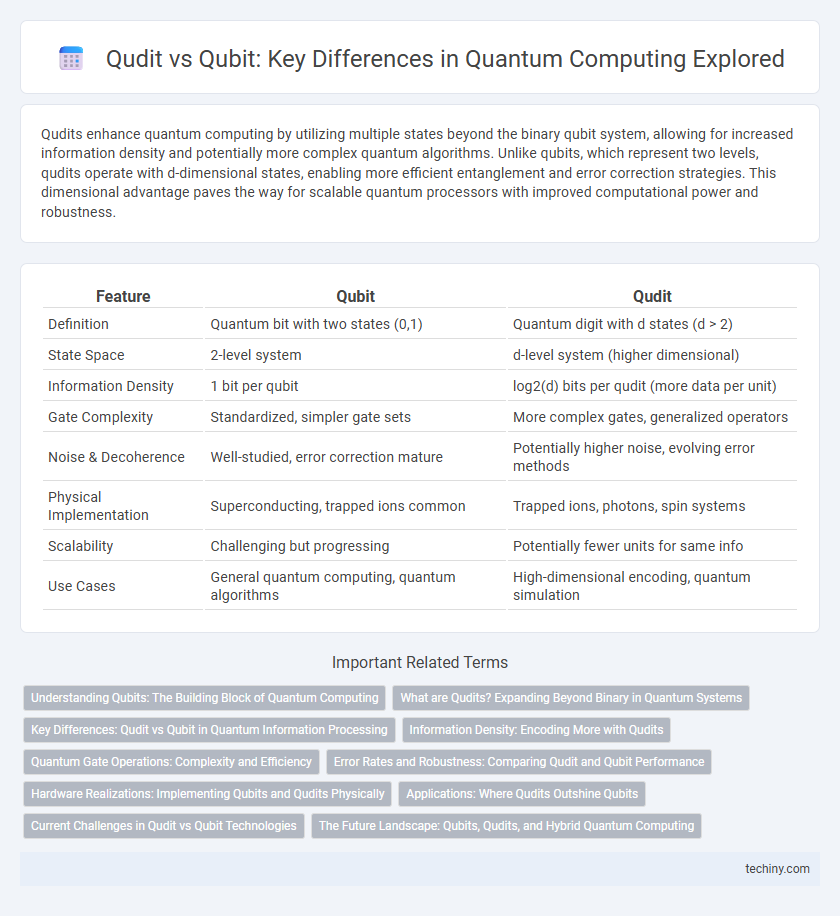Qudits enhance quantum computing by utilizing multiple states beyond the binary qubit system, allowing for increased information density and potentially more complex quantum algorithms. Unlike qubits, which represent two levels, qudits operate with d-dimensional states, enabling more efficient entanglement and error correction strategies. This dimensional advantage paves the way for scalable quantum processors with improved computational power and robustness.
Table of Comparison
| Feature | Qubit | Qudit |
|---|---|---|
| Definition | Quantum bit with two states (0,1) | Quantum digit with d states (d > 2) |
| State Space | 2-level system | d-level system (higher dimensional) |
| Information Density | 1 bit per qubit | log2(d) bits per qudit (more data per unit) |
| Gate Complexity | Standardized, simpler gate sets | More complex gates, generalized operators |
| Noise & Decoherence | Well-studied, error correction mature | Potentially higher noise, evolving error methods |
| Physical Implementation | Superconducting, trapped ions common | Trapped ions, photons, spin systems |
| Scalability | Challenging but progressing | Potentially fewer units for same info |
| Use Cases | General quantum computing, quantum algorithms | High-dimensional encoding, quantum simulation |
Understanding Qubits: The Building Block of Quantum Computing
Qubits serve as the fundamental units of quantum information, encoding data as quantum states that can exist in superpositions of 0 and 1 simultaneously, unlike classical bits. Qudits extend this concept by utilizing multiple levels, offering higher-dimensional quantum states that enable increased information density and potentially more powerful quantum operations. Understanding qubits' coherence, entanglement properties, and error correction challenges is essential for advancing scalable quantum computing architectures.
What are Qudits? Expanding Beyond Binary in Quantum Systems
Qudits are quantum computing units that extend beyond the binary framework of qubits by utilizing d-level quantum systems, where d can be any integer greater than two, increasing the computational space exponentially. Unlike qubits limited to states |0> and |1> , qudits leverage multiple orthogonal states, enabling enhanced information density and more complex algorithms within fewer particles. This multidimensional approach significantly improves error tolerance, gate efficiency, and scalability in quantum processors, pushing the boundaries of quantum information processing.
Key Differences: Qudit vs Qubit in Quantum Information Processing
Qudits extend quantum computing beyond qubits by utilizing d-level quantum systems instead of just two levels, offering higher information density per unit. This enables more efficient quantum algorithms and error correction schemes due to increased state space dimensionality. The complexity of controlling and coherently manipulating qudits presents technical challenges compared to the relatively simpler qubit operations.
Information Density: Encoding More with Qudits
Qudits enhance information density by encoding multiple states beyond the binary framework of qubits, utilizing d-level quantum systems to represent more information per quantum unit. This higher-dimensional state space enables more complex computations and data encoding within fewer quantum elements, improving efficiency in quantum algorithms and error correction. Practical implementations of qudits leverage physical systems such as trapped ions or photonic modes, significantly expanding quantum information capacity compared to traditional two-level qubit architectures.
Quantum Gate Operations: Complexity and Efficiency
Quantum gate operations on qudits offer enhanced computational complexity by enabling higher-dimensional state manipulations compared to qubits, which operate strictly within two-level systems. This increased dimensionality reduces the number of gates required for certain algorithms, improving operational efficiency and potentially simplifying quantum circuit design. Consequently, qudit-based quantum gates can accelerate processing speed and decrease error rates, making them promising for scalable quantum computing architectures.
Error Rates and Robustness: Comparing Qudit and Qubit Performance
Qudits, which utilize d-level quantum systems instead of the binary levels in qubits, demonstrate enhanced error resilience by distributing quantum information across multiple states, reducing the likelihood of decoherence. Studies reveal that qudits exhibit lower error rates in certain quantum operations due to their higher-dimensional Hilbert spaces, improving fault tolerance in quantum circuits. This intrinsic robustness enables scalable quantum computing architectures with potentially fewer physical resources compared to conventional qubit-based systems.
Hardware Realizations: Implementing Qubits and Qudits Physically
Qubits in quantum computing are typically realized through two-level systems such as superconducting circuits, trapped ions, and quantum dots, exploiting properties like spin or polarization. Qudits extend this concept by utilizing multi-level quantum systems, often implemented in trapped ions or photonic platforms, allowing for more robust encoding of information within a single quantum element. Hardware realizations of qudits offer higher-dimensional state spaces which can enhance computational power and error resilience compared to traditional qubit architectures.
Applications: Where Qudits Outshine Qubits
Qudits, utilizing multiple levels beyond the binary states of qubits, enable more efficient encoding and processing of complex quantum algorithms, particularly in quantum error correction and quantum cryptography. Their higher dimensionality allows for enhanced information density and robustness in quantum communication protocols, outperforming qubits in secure key distribution. In quantum simulations, qudits offer superior modeling of multi-level physical systems, making them invaluable for advancements in quantum chemistry and materials science.
Current Challenges in Qudit vs Qubit Technologies
Qudit technologies face challenges in error correction and coherence times compared to qubits due to their higher-dimensional state space, which increases the complexity of maintaining quantum coherence. Implementing reliable multi-level quantum gates for qudits requires advanced control techniques and precise hardware calibration that are still in early development stages. While qubits benefit from more mature fabrication and algorithmic frameworks, scaling qudit systems demands overcoming noise sensitivity and cross-talk issues unique to multi-level quantum systems.
The Future Landscape: Qubits, Qudits, and Hybrid Quantum Computing
Qudits offer a higher-dimensional state space compared to traditional qubits, enabling more complex information encoding and potentially reducing the quantum circuit depth for certain algorithms. Hybrid quantum computing architectures combining qubits and qudits are emerging as a promising approach to balance hardware constraints and computational power, leveraging the advantages of both systems. Research indicates that integrating qudits can enhance error resilience and increase the scalability of quantum processors, shaping the future landscape of quantum technologies.
qudit vs qubit Infographic

 techiny.com
techiny.com